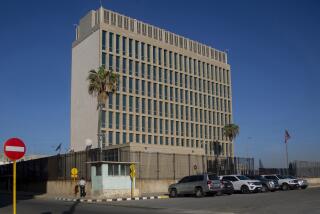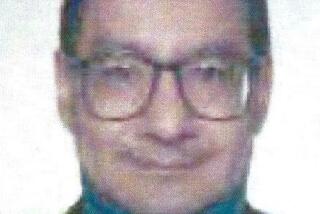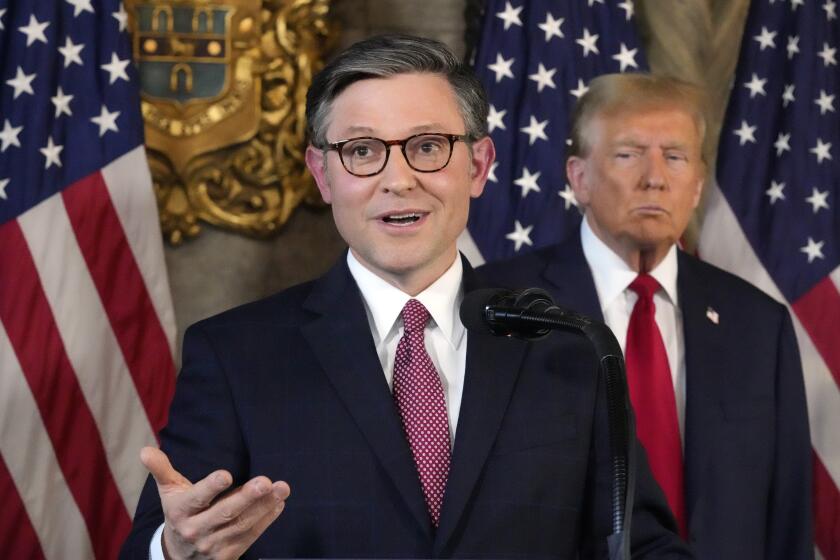Op-Ed: Fidel Castro, the man who couldn’t be killed — at least not by the CIA
There is a safe somewhere in the Central Intelligence Agency’s headquarters in Langley, Va., that very likely contains a sort of tribute to Fidel Castro. It’s a Cohiba, the cigar favored by the Cuban leader, dusted with one of the world’s most lethal poisons — botulin toxin.
“Merely putting one in the mouth would do the job,” John Earman, an inspector general of the CIA, wrote in 1967. By “job” he means assassination. Under orders from Presidents Dwight D. Eisenhower and John F. Kennedy, the CIA devised numerous plots to kill Castro. The revolutionary turned communist survived White House enmity for half a century.
The Cohiba was found after CIA Director Richard Helms ordered Earman to get the truth behind rumors in the press of the assassination attempts. Earman’s little-noticed 1967 report was finally made public in 1998.
The toxic stogie was the work of Dr. Edward Gunn, chief of medical services of the CIA’s operations division. Gunn’s career defied the Hippocratic pledge: “First, do no harm.” At the dirty tricks division, according to Earman’s report, Gunn was Dr. Do Harm.
Gunn carved out the guts of a Paper Mate ballpoint pen. Inside, he placed a syringe so fine that Castro would feel only a slight nick as poison was injected.
In 1961, Gunn had prepared a box of 50 poisoned cigars, meant to land on Castro’s desk in Havana. They were never delivered, and all but one were destroyed in 1963. The Cohiba that remained in the agency’s permanent repository was a matter of some pride for the doctor. Although six years old, it “was still 94% effective,” the inspector general’s report said. It could still have caused Castro a quick and horrible death.
Gunn devised other attacks as well. In 1960, the CIA hired two certified mobsters — Sam Giancana of Chicago and Johnny Roselli of Las Vegas, the report said. Both patriots refused the $150,000 CIA assassination fee. But they balked at blasting Castro during a speech in Revolutionary Square. They insisted on poison that would be slipped by their Havana agent into Castro’s teacup.
Gunn had trouble with the poison pill. Instead of instantly dissolving, it was still there after a night in a water glass. When tested, it failed to kill the guinea pigs. Finally, Gunn managed to send a monkey to a screeching death. Although the pill arrived in Havana, Giancana reported his agent “got cold feet.”
Kennedy’s failure to overthrow Castro in the 1961 Bay of Pigs fiasco produced constant Republican attacks on his leadership. It resulted in what the inspector general’s report termed “severe” pressure by Kennedy to eliminate Castro. Once more, Giancana and Roselli were recruited, and once again Gunn provided the means. This time, the poison was inserted in a pencil with a secret compartment carved by the good doctor. Once more, Havana agents failed.
“The plot was aborted and the pills returned,” the inspector general said.
By 1963, Desmond Fitzgerald had taken charge of the CIA’s Cuban Task Force. Fitzgerald became renowned at Langley for the laughter his schemes produced. They never got out of the lab. There was the midget submarine for planting explosives in a sea mollusk near Castro’s favorite skin-diving area. And a plot to dust the interior of a skin-diving suit with bacteria that would cover his body in Madura-foot tumors, and another to infect his underwater oxygen system with tuberculosis bacteria.
“The fruitless and, in retrospect, often unrealistic plotting should be viewed in that light,” Earman wrote.
The final attack was planned — but never carried out — in 1963 after one of Castro’s closest associates was approached by the CIA. He was Major Roland Cubela Secades, a bearded student revolutionary who is pictured alongside Castro and Che Guevara in post-revolution victory photographs in 1959.
According to his CIA handler, Nestor Sanchez, Cubela hoped for American recognition as Castro’s successor once his former comrade was dispensed with. He asked for explosives and automatic weapons with telescopic sights to do the job. As a physician, Cubela said, he could devise other methods as well. Gunn helped out.
In his CIA lab, Gunn carved out the guts of a Paper Mate ballpoint pen. Inside, he placed a syringe so fine that Castro would feel only a slight nick as poison was injected. Cubela was not impressed with Gunn’s handiwork when Sanchez delivered it to him in a Paris hotel room. Even so, he placed it in his pocket. Cubela said he would devise his own poison for the syringe.
It was Nov. 22, and as Sanchez and Cubela walked downstairs to the hotel lobby, they learned Kennedy had been assassinated in Dallas. According to Sanchez, Cubela was rocked by the news.
“Why do bad things happen to good people?” Castro’s would-be assassin asked his CIA handler.
Pulitzer Prize-winning reporter Patrick J. Sloyan is the author of “The Politics of Deception: JFK’s Secret Decisions on Vietnam, Civil Rights and Cuba.” He is working on a book about Ronald Reagan.
Follow the Opinion section on Twitter @latimesopinion and Facebook
More to Read
A cure for the common opinion
Get thought-provoking perspectives with our weekly newsletter.
You may occasionally receive promotional content from the Los Angeles Times.






